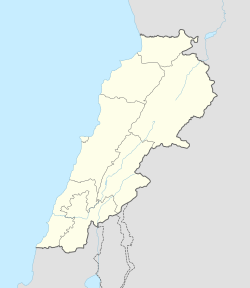Our website is made possible by displaying online advertisements to our visitors.
Please consider supporting us by disabling your ad blocker.
Phoenician sanctuary of Kharayeb
معبد الخرايب الفينيقي | |
 Illustrative reconstruction of the sanctuary | |
| Location | Kharayeb, South Lebanon |
|---|---|
| Coordinates | 33°20′45″N 35°16′53″E / 33.3459°N 35.2815°E |
| History | |
| Founded | Iron Age II |
| Abandoned | First century BC |
| Cultures | Phoenician, Hellenistic |
| Site notes | |
| Excavation dates |
|
| Archaeologists | |
| Condition | Ruined |
| Public access | Yes |
The Phoenician sanctuary of Kharayeb (Arabic: معبد الخرايب الفينيقي) is a historic temple in the hinterland of Tyre, Southern Lebanon, that was excavated in three stages. In 1946, Maurice Chehab, head of Lebanon's Directorate General of Antiquities, led the first mission that revealed a Hellenistic period temple and thousands of clay figurines dating from the sixth-to-first centuries BC. Excavations in 1969 by Lebanese archaeologist Brahim Kaoukabani and in 2009 by the Government of Italy yielded evidence of cultic practices, and produced a detailed reconstruction of the sanctuary's architecture.
The sanctuary originated in the sixth century BC with the establishment of rural agricultural centers near the growing city of Tyre. Initially, a temple was likely constructed from perishable materials. Only fragments of stone cultic statues survive from this phase. Around three centuries later during the Hellenistic period, a larger building fronted by a paved courtyard leading into a square hall and a smaller rectangular room., replaced the original structure. The interior was embellished with stucco, a central mosaic flooring and gem-like, glass-paste wall decorations. The exterior had a cavetto cornice, a lintel with a sun disk and two uraei—representations of a sacred snake used as a symbol of sovereignty and divinity in Ancient Egypt—and the entrance was flanked by two standing Egyptian-style, male-figure statues. The architecture followed pre-Classical Phoenician temple design, which is characterized by features such as a "bent-entry" and an east-west orientation.
The sanctuary yielded a collection of thousands of terracotta figurines and miniature vessels, and inscriptions that provide evidence of the religious practices of the local Phoenician population. The terracotta figurines from the Iron Age II and Persian periods depicted pregnant women, male figures, and deities. During the Hellenistic period, new molding techniques introduced Greek themes, and images of deities such as Aphrodite and Hermes. The religious practices observed at the sanctuary remained faithful to local Phoenician traditions, and were part of a wider cultic system that was practiced in the Tyre hinterland, involving similar rituals in other sanctuaries in the region. The deity to whom the sanctuary was dedicated remains unidentified because the unearthed inscriptions lack specific god names. Child figurines that were excavated from the site suggest the sanctuary served as a small, rural, religious site that focused on healing and salvation deities, and rituals associated with childbearing and childhood. The discovery of around 8,000 terracotta figurines indicates intensive religious activity spanning centuries that ended in the first century BC.
Previous Page Next Page




